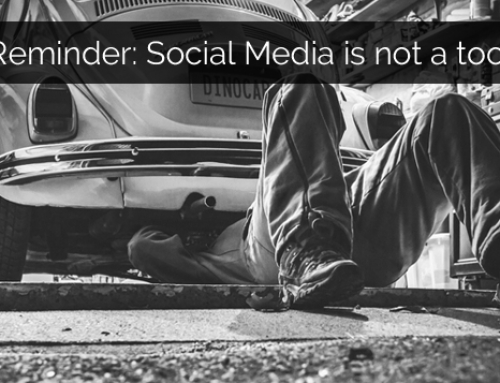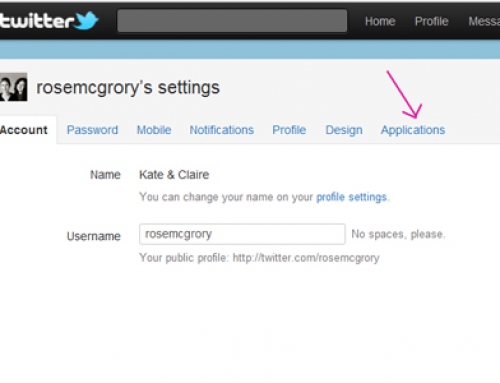Disappointment. Not a word anyone usually wants to hear in a business meeting, but music to our ears.
The theme of this last week’s work with some new clients has been disappointment – feeling that they started investing time in social media because the world and his dog had told them it was a sure fire route to business growth, and it’s not turned out that way. But as with so many things in life, the devil is very much in the detail – So here are our top five social media failure points, and what you can do about them.
1. Inconsistency
This one’s really a failure to integrate social media properly alongside the other regular key tasks for your marketing. You’re set up on all the main social media sites, but only find time to check and update them sporadically. From your contacts’ point of view, that means you’re either swamping them with updates (“might as well post everything I can think of on Twitter while i’m here“) or absent and not holding your end of the conversation. You’d not dream of leaving your email inbox unchecked for a week or more, so why do the equivalent on social media?
The remedy: Decide how frequently it’s realistic for you to post – and stick to it. Even a regular monthly update on your Facebook page is much better than nothing for three months, and then three posts at once. Scheduling tools like Hootsuite or Tweetdeck are your friend here. Secondly, make your social media part of your regular schedule, or get someone else to do it for you. You need to be checking your incoming contacts daily as by tomorrow, they’ll very likely have moved on and not be listening to your response.
2. Lack of reach
Like any marketing activity, only a small proportion of people seeing your communication will either read or act on it – so good reach is vital. By “reach”, we mean a sufficient quantity of first degree connections (ie direct Followers, Likers etc) and a willingness for them to interact with you in ways which make you visible to their own networks ( a Twitter re-tweet, or commenting on your Facebook posts for example).
DON’T confuse reach with the absolute number of your Followers or Likers – here’s what happens if you do.
The remedy: Sit down and take a half hour or so to develop a “good follower” profile. What type of people, in what area of the world, do you need to reach out to?
This list will have something in common with your target prospect characteristics but probably won’t be the same; remember to allow for influencers who may never buy from you, but who can be very effective in increasing your visibility. Then start building relationships with those people, rather than just increasing your follower count with meaningless numbers.
3. The PR trap
We still see lots of businesses who haven’t understood the difference between social media and their other marketing channels, and constantly post old-style “push” marketing content. If most of your content could be summarised as “look how great we / our products are” then this may be your problem. Nobody, and I mean NOBODY, gets a social media account so that they can receive advertising, so your contacts are most likely tuning you out completely.
The remedy: This all comes down to value. You need to be offering something of value to your contacts BEYOND what they’d get from reading your corporate website or trade magazine advertorials. So, brainstorm all the types of content you could post which provide some kind of value. For example, are you tapped into industry developments and able to be their first port of call for breaking news? Can you search out content which helps them solve problems (like this article, for example 😉 )?
That’s not to say some of your content can’t subtly promote your key marketing messages, but put yourself in your contacts’ shoes: a photo captioned “here’s Emma in her pyjamas at 5am because we’re leaving for X trade show” is much more fun to read than “we’re exhibiting at X trade show on the 12th of June”.
4. Tumbleweed
AKA, total lack of engagement. You’ve got a good, relevant following, but they don’t converse with you or advocate on your behalf. Your @mentions Twitter tab is empty apart from spammers, and your Facebook page is a one-way conversation with yourself.
Remedy: This one isn’t easy, we’d be the first to admit. People are busy, and often they’re happy to read but don’t feel the need to engage. To help make them reach for that “reply” button, compelling content helps (see above), as does asking the odd direct question and making them think less hard about responses – yes, sometimes that does mean you’re going to end up talking about what you had for lunch. What’s so bad about that – would you refuse to discuss anything but hardcore strategy in a face to face meeting?
5. Bad Manners
You get past all the previous tests but relationships don’t progress beyond an initial contact. They comment or reply to you once, or maybe just follow you and say Hi. Then you turn them off with what they see as poor etiquette, and you don’t hear from them again.
The remedy: Make sure you’re polite and considerate at all times. On Twitter for example, consider greeting new followers IF they’re genuinely relevant and of interest to you, and starting a conversation. Check their bio before you respond . Our names are clearly in our bio, but we lose count of the responses addressed to “Rose” – not a huge deal, but not endearing either. Think about your followback policy on Twitter (and following Facebook comments by Liking the originating page). Thank people who share or otherwise pass on your content. And obviously, always reply to messages or Facebook comments!
We hope these help you in the direction of a great social media presence, and if you’re still struggling, why not book one of our private consultancy and training sessions? One of our clients this week summed up the benefits perfectly:
“I really enjoyed {the session} and found it extremely useful. It was so great to have you focus completely on our business and make the real time changes to our pages. I felt you really understood our products, market and strategy.”
– more music to our ears!




Hi Kate and/or Claire
Great article thank you – I’ve passed it on to a couple of clients who struggle with the inconsistency bit.
Only one thing I have to take issue with. Can you really blame anyone for calling you Rose on Twitter? I’ve been following you for ages and I’ve even met you but if I want to address you by name I have to click on your profile to find the right name. That’s a big ask in Twitter world.
I still advocate people using their own names on Twitter in preference to a business name and know lots of folk who’ve changed from biz to personal and found it more rewarding. After all, our business is only part of who we are.
Hi Ann,
Thanks, glad you liked the article. You’re right of course about the name check; it’s something we always do if we want to make a good impression, but yes it’s an extra click for our new contacts.
In our case, we both also tweet from personal accounts with a focus on specific non-work interests, and prefer to keep some separation between our professional and private lives – I realise this is a contentious issue in the age of the “transparency” buzzword, but I think there’s a difference between being inauthentic and doing the online equivalent of banging on about your trainspotting obsession in the office.
Plus, if there’s one thing Twitter doesn’t need more of, it’s individual “social media expert” accounts – another reason we focus on trying to provide a combined feed of the highest quality content we come across!
~best, Claire
This is so true you have to engage with people otherwise you get no return and then you will just give up. With social media you have to think outside the box and be consistent. Then You will see the benefits of digital marketing.